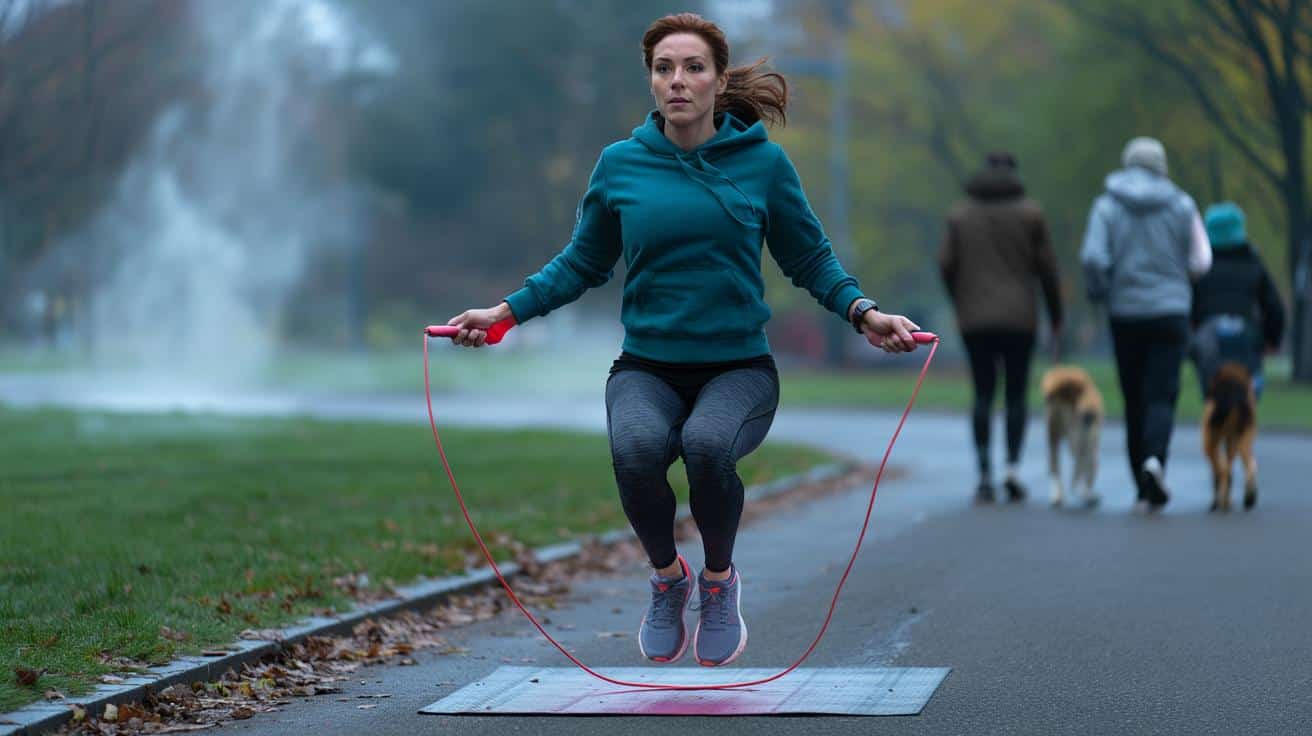You want something that fits between emails, slices through brain fog, and actually moves the needle. Walking is lovely, but it’s slow medicine. There’s a simple, scrappy workout that torches more energy, spikes fitness faster, and asks only for a rope and two square metres. It looks playful. It isn’t.
42am on a grey Tuesday and the park is full of coffee-walkers. In the corner, a woman in a hoodie steps over a thin blur of rope. Tap-tap-tap. Thirty seconds fire, thirty seconds float. She checks her phone, breath steady, cheeks bright. Six minutes in, steam rises off her like a kettle.
By the time the dog walkers finish their loop, she’s packing the rope away. Ten minutes total. No fuss, no selfie. Her watch shows a heart-rate peak most people only see on a hill sprint. The numbers are startling.
The four-times workout: skipping intervals
Skipping – the humble jump rope – isn’t cute cardio. It’s a compact engine. Each hop loads your calves, quads, core and shoulders, while the rope enforces rhythm and pace.
Minute for minute, it outmuscles a stroll. **At a fast pace, skipping can be at least four times more effective than walking, minute for minute.** That’s because it drives your heart rate into zones most people only reach in a spin class.
Here’s a concrete snapshot. A 70kg person walking at a brisk clip burns around 4 calories a minute. The same person skipping at a lively cadence hits roughly 15–17 calories a minute. That’s not a rounding error. It’s a different league.
Office worker Sam, 38, swapped his lunchtime walk for ten-minute skipping intervals, three times a week. In six weeks, his resting heart rate fell by 7 beats, his trousers eased at the waist, and his runs felt lighter. Same lunch hour, bigger return.
Why does it work so hard? Skipping is high cadence, low travel. The rope sets a metronome you can’t cheat, pulling you into short bursts near your max sustainable effort. Those bursts improve VO₂ max, build ankle stiffness for better running economy, and stack a gentle afterburn once you stop.
Your feet leave the ground, but the jumps are small, the landing soft. The bones get a friendly nudge, the tendons store and release elastic energy, and the brain gets sharp from the coordination. *Your heart will know it’s working.*
How to start: a 10‑minute plan that fits a busy day
Start simple. Two minutes easy skip. Then 7 rounds of 30 seconds fast, 30 seconds easy. One minute slow to finish. **Ten minutes of intervals can rival a 40‑minute brisk walk for calorie burn and cardio dose.**
Keep the rope short enough that the handles reach your armpits when stood on. Jump on a forgiving surface – wood floor, rubber mat, short grass. Land softly on the balls of your feet. Wrists turn the rope; shoulders stay relaxed.
Worried about coordination? Use ghost reps first: mimic the movement without a rope for a minute, then add the rope for 20 seconds. Build cadence later. We’ve all had that moment where the rope snaps our toes and pride in one go. Breathe, smile, try again.
Shins grumbling? Switch to a 20/40 split for a week, or alternate rounds with marching high knees. Flat-footed landings hurt; soft, quick, tiny jumps feel kind. Let your calves adapt for a fortnight before chasing speed. Let’s be honest: nobody does that every day.
There’s a mindset shift too: small, punchy, done. **You don’t need a gym, just a rope and two square metres.** That freedom changes consistency.
“Skipping is the most portable high-intensity tool I give busy clients. Ten minutes turns a hallway into a cardio studio,” says coach Aisha Rahman.
- If impact worries you, try a cordless rope to learn rhythm with less trip risk.
- Swap in step-overs or boxer step if basic jumps feel stale.
- Aim for conversation-broken breathing on the “fast” parts, not total meltdown.
- New shoes help: a little cushioning, secure heel, nothing fancy.
Keep walking, but unlock the micro‑workout mindset
Walking is still a gem for mood, creativity, and joints. Keep it. Use it. Just don’t pretend it’s the same stimulus. Skipping intervals are the espresso shot; walking is the long, kind cup of tea.
Think of your day as a grid of tiny opportunities. Ten minutes before a shower. A lull after a meeting. Rope in the bottom drawer, ready. Those micro‑sessions pile up into a cardiovascular bank balance you can feel when stairs stop being stairs.
You might find the ritual oddly grounding. The swish of rope. The dim ache in your calves as the work lands. Share your split times with a friend, trade playlists, set a silly challenge for Friday. The best part is how ordinary it becomes.
| Key point | Detail | Interest for readers |
|---|---|---|
| Skipping intervals deliver 4× the calorie burn of walking | 12–14 METs for fast skipping vs ~3–4 METs for brisk walking | Faster progress in less time, especially on busy days |
| A 10‑minute plan is enough | 2‑minute warm‑up, 7× (30s hard/30s easy), 1‑minute cool‑down | Clear, doable structure with a measurable finish line |
| Low kit, high payoff | Rope, trainers, a soft surface; optional cordless handles | Cheap, portable, apartment‑friendly cardio with skill growth |
FAQ :
- Is skipping bad for knees?Not usually. The jumps are small and the landings springy. Start on a soft surface, keep reps short, and build gradually. If you’ve got knee pain, test a 20/40 split and stop if pain lingers after.
- What if I can’t coordinate the rope?Begin with ghost jumps for rhythm, then use a cordless rope to remove the trip hazard. Add the real rope for 10–20 seconds at a time. Coordination improves quickly with short, frequent practice.
- How many days a week should I do it?Two to four sessions work well for most. Alternate with walking or strength days. If you’re very new to impact, start twice weekly and let your calves adapt for two weeks.
- Will it help with weight loss?It can. Higher burn per minute makes the maths friendlier, and intervals curb appetite spikes for some people. Pair with protein‑rich meals and plenty of sleep for the best nudge.
- No rope handy—now what?Do “silent skipping”: same footwork, small hops, quick wrists, no rope. Or try high‑knee runs in place with a 30/30 split. Different tool, similar heart‑rate story.









